Holidays are more than just dates on the calendar; they are an embodiment of culture, values, and cherished memories. As societies become increasingly diverse, the opportunity to integrate new holiday traditions into celebrations such as Christmas, Kwanzaa, and Hanukkah arise. Embracing these traditions not only promotes inclusivity but also enhances the richness of these festive seasons. Here’s how to thoughtfully integrate new holiday customs into these celebrations.
Embrace the Spirit
Begin by embracing the spirit of curiosity and openness. Learn about the diverse cultures and traditions that are relevant to the holiday you are celebrating. Understand the historical significance, rituals, and values associated with each tradition. This knowledge lays the foundation for meaningful connections.
Blend Culinary Delights
One of the most enjoyable aspects of holidays is the food. Incorporate dishes and recipes from various cultures into your holiday feasts. Whether it’s adding a Kwanzaa-inspired dish to your Christmas dinner. Or you can include a Hanukkah specialty during Boxing Day. Culinary fusion can be a wonderful way to honor multiple traditions.
Share Stories
Holidays are an ideal time to share stories and teachings from different cultures. Incorporate storytelling sessions where each family member or guest shares a tale from their heritage or a tradition. This not only educates everyone about new customs but also fosters a sense of unity.
Meaningful Gifts
When exchanging gifts, consider selecting items that hold significance in the traditions you’re integrating. This could be a book about the principles of Kwanzaa, a symbolic ornament from Hanukkah, or a handmade decoration that represents a cherished Christmas custom.
Volunteer and Give Back
Many holiday traditions emphasize the importance of giving back to the community. Integrate this value by participating in volunteer activities. These should align with the principles of the holidays you’re celebrating. This not only integrates new customs but also embodies the true spirit of the festive season.
Encourage Dialogue
Create an open space for discussions about the new traditions you’re integrating. Encourage family members and friends to share their thoughts, feelings, and questions. This fosters a sense of inclusivity and promotes a learning environment.
Respect and Sensitivity
Above all, approach the integration of new holiday traditions with respect and sensitivity. Ensure that the customs you’re adopting are authentically represented and celebrated. Avoid cultural assumptions by engaging in thorough research and consultation with members of the respective cultures.
Finally, integrating new traditions into celebrations like Christmas, Kwanzaa, and Hanukkah is a way to honor diversity and foster understanding. By embracing a spirit of exploration, culinary fusion, and respectful engagement, you can create festive season for everyone.




